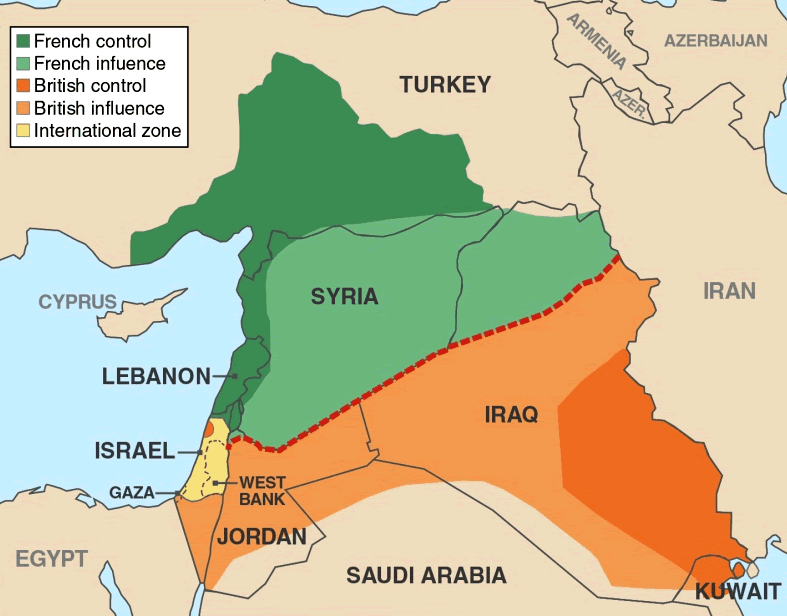 |
| Sykes-Picot Agreement |
The Sykes-Picot Agreement was a secret agreement between the British and the French regarding the dispensation of Ottoman territory in the Middle East. François Georges-Picot represented the French and Mark Sykes represented the British.
Formalized in May 1916 at the height of World War I, the agreement was based on the assumption that the Allies would win the war (by no means certain in 1916), and as a result, the Ottoman Empire that had sided with the Germans would be dismembered.
Under the Sykes-Picot Agreement, France was to gain spheres of influence, or direct control, over most of the Arab territories of present-day Syria and Lebanon as well as southeastern Turkey, including the area around Alexandretta. The British were to gain control over much of present-day Iraq and Jordan and areas in Palestine around the northern port of Haifa.
  |
The rest of Palestine, including the holy cities of Jerusalem and Bethlehem, was to fall under international control. At the time none of these areas existed as independent states but had been ruled as provinces of the Ottoman Empire since the 16th century.
Under later terms, Russia, an ally in the war at the time, was to receive Armenia and parts of Kurdistan. Russia also hoped that this would mean the realization of its long-held dream to control access into the Mediterranean from the Black Sea through the Strait of the Dardanelles
The Italians, also allies, were to expand in the Aegean and western Turkey around the major city of Izmir. The area of present-day Saudi Arabia was not included in the arrangement because in 1916 oil had not yet been discovered there and the territory was not considered of economic or political importance.
The portions of the agreement involving Russia were nullified when Russia dropped out of the war early through a separate treaty with Germany. Owing to Mustafa Kemal Atatürk's successful military defense of the Anatolian Peninsula, Turkey was not partitioned after the war, nor was it occupied for any length of time.
As some British foreign office officials warned at the time, portions of the Sykes-Picot Agreement contradicted the secret agreements made with the Arabs in the Sherif Husayn–McMahon correspondence. The Balfour Declaration regarding Zionist, or Jewish national, aspirations in Palestine, issued publicly in 1917, further complicated the issue of control over that territory.
The terms of the Sykes-Picot Agreement involving Arab territories were formalized in the 1920 San Remo Treaty and in the League of Nations in 1922, whereby Syria and Lebanon became French mandates and Palestine
Consequently, in the post–World War I era, the Arabs not only failed to receive independence, but they were also divided into separate nations ruled by two different imperial powers. Nor did the Zionists realize their dreams of an independent Jewish state. The consequences of these decisions continued to cause conflict in the region into the 21st century.